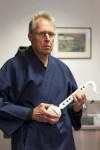An orchestra of instruments that resemble giant musical notes with head-shaped bulbs will fill the Broad Art Center with synthesized sounds Tuesday.
The instrument, known as an otamatone, is a piece of Japanese device art that Erkki Huhtamo, a professor in design media arts, will showcase in an otamatone orchestra comprising UCLA design media arts students. The ensemble, along with other device-art gadgets, will be on display at “Presentation of Japanese Device Art” in the Broad Art Center on Tuesday. Device art is a form of artwork that serves a practical purpose but can also be appreciated for its aesthetic appeal, said Huhtamo.
“(Device art is) an art movement, but it’s also, at the same time, something that leaks into popular culture and design and these other forms,” he said.
At the presentation, Huhtamo plans to showcase various objects and instruments within the Japanese device art genre, including the chihuahua whistle, a round whistle that often features animal designs, and the knockman, a figurine that produces mechanical sounds when wound up. He also plans to play the instruments alongside the UCLA otamatone orchestra, which will play original compositions. Members of the orchestra created the compositions by working off one other’s improvisational and experimental sounds.
Huhtamo said Maywa Denki, a Japanese company created by Masamichi Tosa and Novmichi Tosa, pioneered Japanese device art through gadgets such as the otamatone. Now, the company and the device art inventions it produces are well-known in Japan.
Sam Congdon, a graduate student in design media arts and a member of the orchestra, said device art, specifically the otamatone, should be viewed as a multipurpose object – unlike guitars or pianos, which are primarily instruments that only make music. The otamatone, for instance, encompasses multiple categories by functioning as an instrument, a piece of art and a toy all at the same time, he said.
Huhtamo said Japanese device art goes against stark Western boundaries between art and design. In Western culture, people view art as primarily aesthetic, while design is more purposeful and instrumental. However, Japan has historically never separated the two categories, he said.
Cameron Masters, a graduate student in art and a member of the orchestra, said art in Japan is more akin to design products, which is why many popular Japanese artists also have toy or household-product lines, composed of items such as lamps. For example, Takashi Murakami, a neo-pop artist in Japan, has collaborated with fashion designers on clothing lines and has produced collectible figurines of his statues.
“(Device art is) not just a performance, it’s not just for commercial benefit and for design purposes,” he said. “It’s interesting in a kind of third space.”
Although Western artists have started blending the categories together, Huhtamo said he thinks the Japanese are still one step ahead. So, educating the public about device art can help show how creativity transcends traditional boundaries and categories.
“On one level, I want to let the students have a good time and be surprised by these things,” Huhtamo said. “At the same time, I also hope it will encourage people to think about the cultural difference (in) the art and design that is being produced; (it) is not the same and identical all around the world.”
